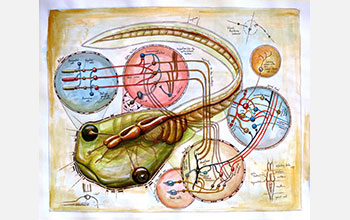Multimedia Gallery
Xenopus tadpole brain circuitry
Researchers found that tadpoles use the optic tectum region of their brain to determine that something is approaching and avoid collision. The finding helps scientists better understand how different neurons work together to control simple behavior in many animals.
More about this image
Neuroscientists at Brown University looked cell-by-cell at the brain circuitry that tadpoles -- and possibly other animals -- use to avoid collisions. The study produced a model of how individual inhibitory and excitatory neurons can work together to control a simple behavior.
Brown scientists tracked the cell-by-cell progress of neural signals from the eyes through the brains of tadpoles as they saw and reacted to stimuli, including an apparently approaching black circle. In so doing, the researchers were able to gain a novel understanding of how individual cells contribute in a broader network that distinguishes impending collisions. The basic circuitry involved is present in a wide variety of animals, including people, which is no surprise given how fundamental collision avoidance is across animal behavior.
The research was supported in part by the National Science Foundation (grant IOS 07-46558).
To learn more about this research, see the Brown news story Dodging dots helps explain brain circuitry. (Date image taken: 2013; date originally posted to NSF Multimedia Gallery: Aug. 25, 2017)
Credit: Arseny Khakhalin
Images and other media in the National Science Foundation Multimedia Gallery are available for use in print and electronic material by NSF employees, members of the media, university staff, teachers and the general public. All media in the gallery are intended for personal, educational and nonprofit/non-commercial use only.
Images credited to the National Science Foundation, a federal agency, are in the public domain. The images were created by employees of the United States Government as part of their official duties or prepared by contractors as "works for hire" for NSF. You may freely use NSF-credited images and, at your discretion, credit NSF with a "Courtesy: National Science Foundation" notation.
Additional information about general usage can be found in Conditions.
Also Available:
Download the high-resolution JPG version of the image. (18.3 MB)
Use your mouse to right-click (Mac users may need to Ctrl-click) the link above and choose the option that will save the file or target to your computer.

